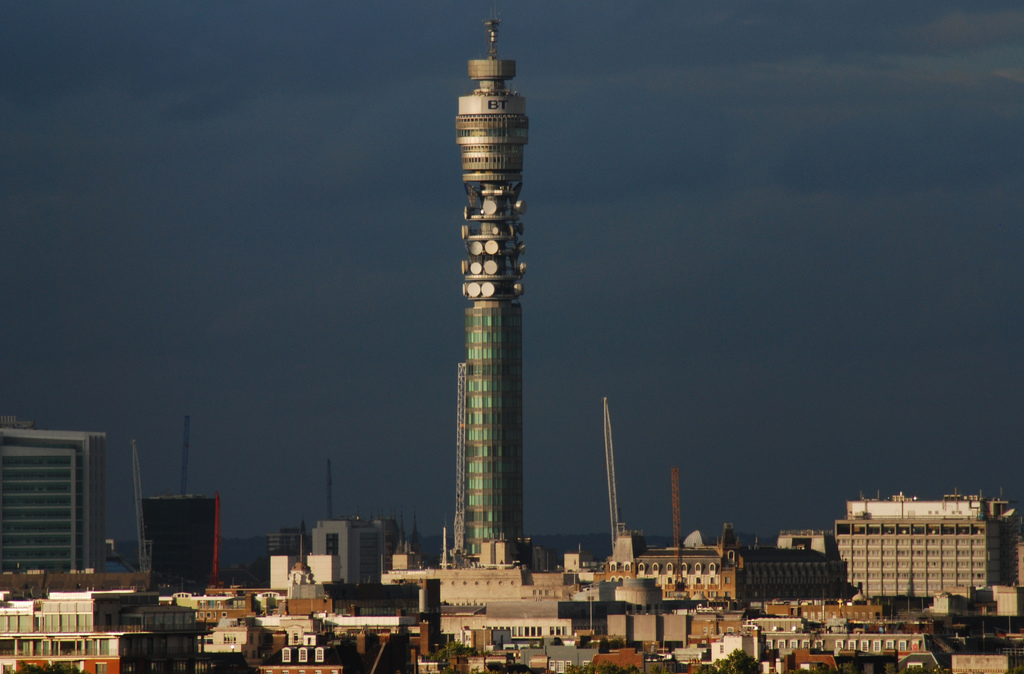Standing tall and proud in a city that is now surrounded by even taller skyscrapers, British Telecom Tower was a marvel of its time. Originally known as the Post Office Tower because it was commissioned by the General Post Office, it was built to handle the nation’s communications traffic which is why the midsection is covered with microwave aerials. Begun in 1961 and completed in 1964, its then-futuristic look led to having a significant role in the Doctor Who serial “The War Machines”. Have a look below at ten interesting facts and figures concerning one of London’s iconic buildings.
Height
At 191 metres or 627 feet, BT Tower was the tallest building in London when it was completed in 1964. Prior to that, the tallest building had been St. Paul’s Cathedral and then Millbank Tower. It held the title of tallest building in London and in the United Kingdom until 1980 on the completion of NatWest Tower (now called Tower 42) in the City of London.
Eyesore
After it was proposed, BT Tower met with harsh criticism that its design was not compatible with the area. The region it is in, Fitzrovia, was a haven for artists and aristocrats alike. The Royal Fine Arts Commission, one of the original critics of the tower in the 1960s, has since reversed course and has since described it as a “building of merit”.
The Numbers
BT Tower was built for a cost of £2.5 million and used 13,000 tonnes of concrete.
Cold War Fears
BT Tower’s circular design wasn’t just because of the microwave aerials’ placement, but also the perceived threat of nuclear attack. Architects Eric Bedford and G.R. Yates noted that the only buildings that survived the nuclear blasts in Hiroshima and Nagasaki were round ones. The round shape of those buildings allowed the blast wave to surge around them.
It’s a Secret
Upon its completion, BT Tower was designated official secret on its completion in 1964. The reason for this was that the microwave aerials didn’t just transmit TV and radio signals, but also military signals. As it was protected by the Official Secrets Act, it did not appear on any map and taking and storing photographs of it was forbidden. Seems a bit silly considering it was easily noticed by anyone in London, not to mention how it was open to the public for fifteen years until 1981. It was officially outed by MP Kate Hoey using parliamentary privilege in 1993 when she stood up and said this in Parliament:
Hon. Members have given examples of seemingly trivial information that remains officially secret. An example that has not been mentioned, but which is so trivial that it is worth mentioning, is the absence of the British Telecom tower from Ordnance Survey maps. I hope that I am covered by parliamentary privilege when I reveal that the British Telecom tower does exist and that its address is 60 Cleveland Street, London
I Thought You’d Be Taller
BT Tower was originally meant to be much shorter, but had to be extended so it could broadcast signals over the Chiltern Hills that form the north rim of the London basin.
Getting with the Times
Many of the original microwave aerials have been removed as digital telecommunications has replaced microwave transmissions. At least 31 of the 57 original aerials have been removed from the building.Because the building is Grade II listed, for the longest time many of the antennas could not be removed without permission, but due to safety concerns, many were finally removed. Keeping up with the digital age, BT Tower houses a Mediahive digital content management system with a storage capacity of 3.6 petabytes (3600 terabytes).
To the Top
The lifts installed in 2000 can go from the bottom floor to the top in 20 seconds. Able to ascend at 7 metres per second, they are amongst the fastest in Europe.
Revolving Restaurant
The 34th Floor was built to incorporate a revolving restaurant that could complete a full rotation every 22.5 minutes. It was run by Billy Butlin and known as The Top of The Tower and ran on nylon bearings and rollers with a two brake horsepower motor. In 1971, it was the target of an IRA bomb placed in the mens toilets, but the restaurant remained open until 1980 when the lease expired amongst security concerns. The restaurant area is now utilised for corporate events. It is occasionally open to the public during London Open House Weekend, but it was not in 2014.
Made the Grade
BT Tower was listed as a Grade II building by the government in 2003.




Isn`t the Natwest Tower (Tower 42) in the City?
Yes my mistake.
No the tower is not in the City of London
The BT Tower is not – he’s talking about the former NatWest Tower, which is in the City of London.
It was actually the Angry Brigade who planted the bomb.
I believe that the bomb was in July of 1973
I had dinner in the Post Office Tower restaurant in 1968, whilst visit my father in London. I will never forget that lovely evening, and the view ! Thank you for bringing back a lovely memory for me.